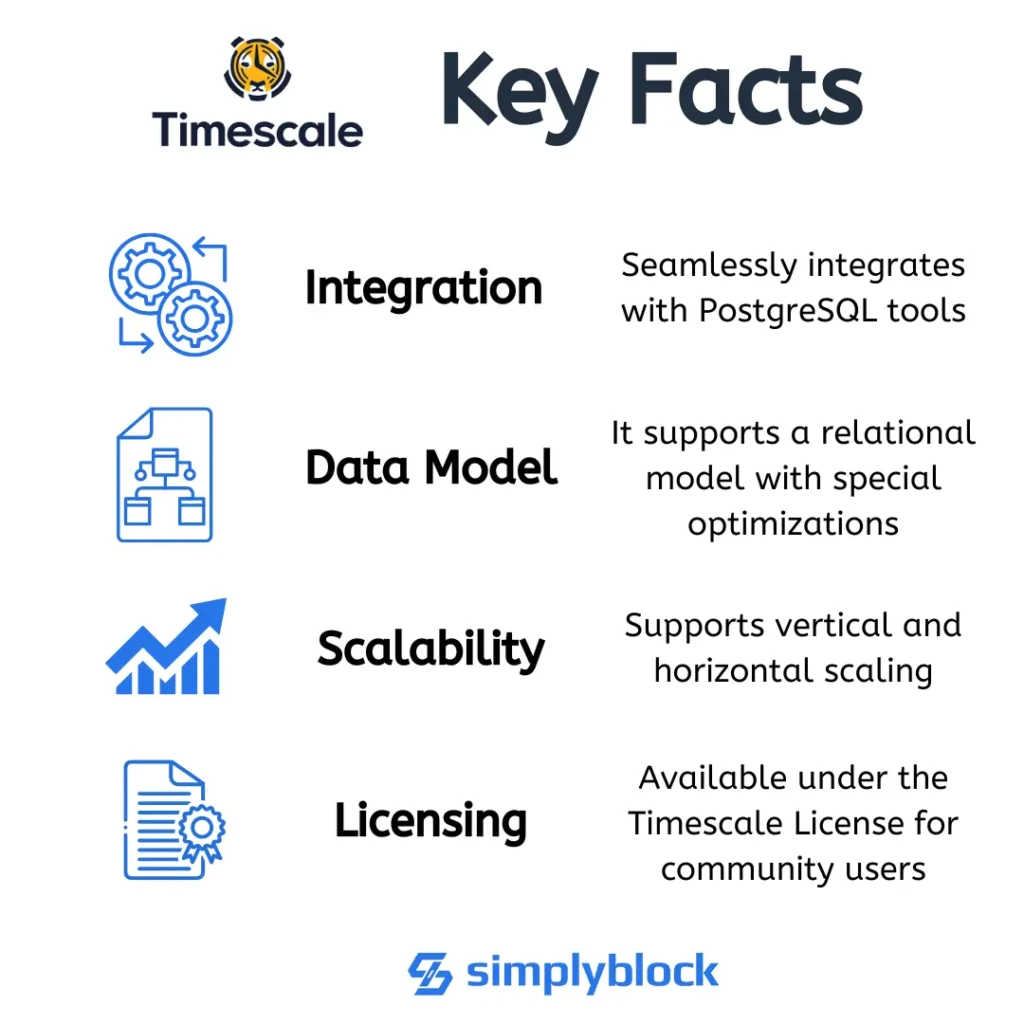Timescale
Terms related to simplyblock
Timescale (or TimescaleDB) is a time-series database built as an extension of PostgreSQL. It brings native support for time-series data to the world’s most trusted relational database engine, offering the ability to handle high-ingestion, high-resolution temporal workloads using standard SQL. Timescale is purpose-built for use cases such as observability, IoT telemetry, financial data, and real-time analytics.
How Timescale Works
Timescale operates as a PostgreSQL extension, leveraging native SQL, indexes, and table structures while optimizing time-series workloads with custom features like hypertables and continuous aggregates.
- Hypertables: Abstract distributed time-series partitions
- Chunks: Subdivisions of hypertables based on time and optional space
- Compression: Native, columnar compression for historical data
- Continuous Aggregates: Materialized views for real-time query acceleration
- Multinode Support: Distributed clustering for horizontal scale
This architecture ensures that TimescaleDB inherits PostgreSQL’s maturity and transactional guarantees while optimizing for write-heavy time-series use cases.
Timescale vs Other Time-Series Databases
Timescale differs from standalone TSDBs like InfluxDB or TDengine by maintaining full SQL support and tight PostgreSQL integration. Here’s how it compares:
| Feature | Timescale | InfluxDB / TDengine |
|---|---|---|
| SQL Support | Full ANSI SQL via PostgreSQL | InfluxQL / limited SQL |
| Architecture | Extension on PostgreSQL | Custom-built engine |
| Transactions & Joins | Supported | Limited or none |
| Ecosystem Compatibility | PostgreSQL tools & connectors | Proprietary interfaces |
| Use Cases | Hybrid OLTP/time-series workloads | Time-series analytics only |
By combining relational features with time-series optimization, Timescale serves both developers and analysts in one platform.

Storage Characteristics of Timescale
Timescale benefits significantly from fast, low-latency block storage, especially when operating at scale. Key storage demands include:
- High IOPS for inserts: Time-series data ingests frequently and in bursts
- Sequential read/write performance: Especially for hypertables and WAL logs
- Compression support: To store large volumes of historical data
- Snapshot compatibility: For backup, replication, and cloning
- Multi-zone availability: Required in HA production setups
For optimal performance, Timescale should be deployed on NVMe over TCP infrastructure, as offered by simplyblock™.
Timescale in Kubernetes and Edge Architectures
Timescale is fully deployable in Kubernetes, but persistent volume performance and management are critical. Using simplyblock’s CSI integration, TimescaleDB clusters can benefit from:
- High-performance NVMe volumes provisioned dynamically
- Support for multi-zone replication
- Instant snapshotting for cloning and recovery
- Secure, multi-tenant isolation for shared clusters
In edge or air-gapped environments, simplyblock ensures performance continuity even with limited connectivity.
Timescale Use Cases
Timescale supports a wide variety of real-time data scenarios:
- IoT sensor ingestion: Telemetry, device logs, environmental data
- DevOps observability: Metrics, logs, and application traces
- Financial analytics: Tick data, order books, and trading signals
- Manufacturing telemetry: Machine health and predictive maintenance
- Smart infrastructure: Power grids, HVAC systems, and automation
Because it supports standard SQL, it integrates cleanly with BI tools, ORMs, and PostgreSQL-compatible APIs.
Simplyblock™ Advantages for Timescale
Timescale deployments become more efficient with simplyblock:
- NVMe-over-TCP for high-ingestion workloads
- Copy-on-write snapshotting for rapid backup or rollback
- Advanced erasure coding for space-efficient fault tolerance
- Thin provisioning for large-scale historical storage
- Performance-optimized SDS for real-time analytics and fast queries
Deploying Timescale with simplyblock ensures scale-out performance and resilience at lower operational cost.
Timescale and the PostgreSQL Ecosystem
As a PostgreSQL extension, TimescaleDB retains full compatibility with PostgreSQL features:
- Indexes, joins, views, and foreign tables
- Full ACID compliance
- Role-based access control and permissions
- Extensions like PostGIS, pg_stat_statements, or pg_cron
- Backups and restore via pg_dump and base snapshots
With simplyblock, Timescale’s snapshot and clone lifecycle can be integrated directly into your CI/CD and disaster recovery plans.
External Resources
- Timescale Official Website
- Timescale GitHub Repository
- PostgreSQL – Wikipedia
- Time-series Database Overview
Questions and Answers
Timescale is a PostgreSQL extension that brings native time-series capabilities to a trusted relational database. It supports high-ingest rates, compression, and time-based queries, making it ideal for observability, IoT, and financial data analytics.
Yes, TimescaleDB works well in Kubernetes when combined with PostgreSQL operators. For stable performance and data durability, use Kubernetes-native NVMe storage to support fast ingest, backup, and failover operations.
Time-series data is write-intensive and benefits from low-latency I/O. NVMe over TCP delivers the throughput required for fast inserts, queries, and retention policies across large datasets.
Timescale leverages PostgreSQL’s encryption options, including integration with external storage encryption. For stronger security in multi-tenant environments, use Simplyblock’s encryption-at-rest at the volume level for key isolation and compliance.
Yes, TimescaleDB offers distributed hypertables via Timescale Forge or multi-node setups. When paired with software-defined storage, it can handle billions of rows with reliable performance across edge and cloud environments.
